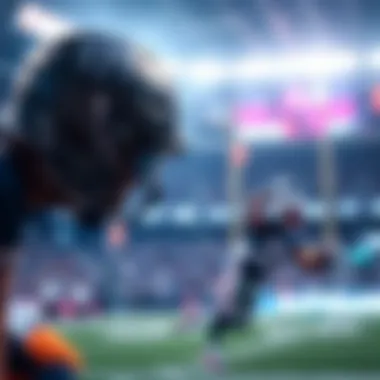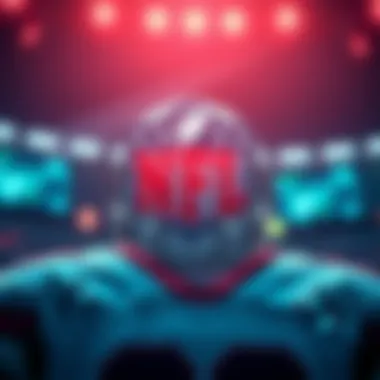NFLPA and NFTs: A New Era in Sports and Technology


Intro
In the fast-moving world of sports and technology, the advent of non-fungible tokens (NFTs) has opened new doors for the National Football League Players Association (NFLPA) and its members. This intersection of digital assets and athlete branding is not just a passing trend; it has the potential to reshape how players engage with their audience and monetize their brand.
As the NFLPA dives into the waters of NFTs, it's essential to understand what lies behind this digital phenomenon. Now more than ever, athletes are looking for innovative means to connect with fans and capitalize on their unique likenesses. The following sections will peel back the layers, revealing the foundational concepts surrounding cryptocurrency and the implications it has for sports.
Understanding Cryptocurrency Basics
What is Cryptocurrency?
Cryptocurrency is a type of digital or virtual currency that employs cryptography for security. Unlike traditional currencies, such as the US dollar or the Euro, cryptocurrencies are decentralized and typically powered by blockchain technology. In simple terms, this means that no central authority governs them, allowing for a more transparent, secure, and trustless transaction environment. Bitcoin is often the first name that comes up in conversations about cryptocurrency, but it's far from the only one.
Key Terminology and Concepts
To navigate the world of NFTs and understand their association with the NFLPA, familiarity with some specific terms is crucial. Here are a few key concepts to clarify:
- Blockchain: A distributed ledger that records transactions across many computers, ensuring security and making it nearly impossible to alter the record retroactively.
- Minting: The process of turning a digital file into an NFT by recording it on the blockchain.
- Smart Contracts: These are self-executing contracts with the terms directly written into code. They manage the transaction and ownership transfers without intermediaries, making processes efficient and secure.
- Interoperability: Refers to the ability of different NFT platforms to function together, facilitating easier transactions and ownership verification across various markets.
With these concepts in hand, the discussion of how the NFLPA integrates NFTs into the realm of athlete branding becomes clearer.
“The rise of NFTs represents more than just a fad; it signifies a transformative shift in how athletes can leverage their brands.”
The NFLPA's Foray into NFTs
Understanding how the NFLPA is approaching NFTs involves recognizing their multifaceted potential. As more players hop on this digital train, fans are not just passive observers; they are becoming vital participants in the athletes' journeys. By turning memorable moments or exclusive content into NFTs, players can offer fans a stake in their storied careers, while reaping economic benefits.
As we dive deeper into this topic, prepare to explore the multifold layers of how NFTs are affecting the dynamics within the sports industry, from branding and monetization opportunities to legal implications and future trends. Let's embark on this journey together.
Foreword to NFLPA and NFTs
Understanding the intersection of the National Football League Players Association (NFLPA) and non-fungible tokens (NFTs) is not only necessary but crucial for grasping how these elements reshuffle the landscape of sports and technology. In today’s digital age, where technology seeps into every crevice of fan engagement, marketing, and personal branding, the union of athletes’ rights and blockchain technology provides a fresh essence to how players connect with their supporters and monetize their brands.
This article offers a thorough exploration into how the NFLPA is leveraging NFTs to enhance athlete branding, increase fan interaction, and create new economic opportunities. With players embracing these digital assets as a means to carve out their space in an increasingly crowded sports arena, understanding this relationship becomes essential for investors, analysts, developers, and enthusiasts alike.
Overview of NFLPA
The NFLPA, established in 1956, stands as the face of the professional football players in the U.S., advocating for their rights and welfare both on and off the field. With over 1,800 active players as members, the NFLPA aims to ensure that players have representation when it comes to negotiations concerning contracts, health programs, and benefits. Over the decades, the NFLPA has evolved to address various issues, including the growing complexities brought upon by modern technology—hence their interest in NFTs.
The association acts as a bridge between players and management, asserting players' voices and negotiating deals that ensure fair treatment. By expanding its role to include digital innovations like NFTs, the NFLPA amplifies its mission—empowering players while embracing new forms of engagement. This transition signifies a noteworthy shift in how the association perceives athlete branding in a rapidly changing digital world.
Defining Non-Fungible Tokens
Non-fungible tokens, commonly known as NFTs, are unique digital assets verified using blockchain technology. Unlike cryptocurrencies such as Bitcoin or Ethereum, which are fungible and can be exchanged on an equal basis, NFTs represent ownership of a specific asset—be it digital artwork, music files, or even video highlights from a game.
Each NFT has unique attributes, making it irreplaceable—just like a one-of-a-kind collector's item in the physical world. The rise of NFTs has garnered significant attention, particularly in the realm of sports, where athletes and organizations are now exploring ways to monetize their unique content in novel ways.
Some significant features that define NFTs include:
- Indivisibility: NFTs cannot be divided into smaller units like traditional currencies.
- Ownership: They provide a digital certificate of authenticity that proves ownership and provenance of a digital item.
- Interoperability: Many NFTs can be bought, sold, or traded across different platforms, increasing their value and versatility.
The marriage of the NFLPA and NFTs allows athletes not only to connect with their fans intimately but also to own and sell pieces of their elusive careers. As the understanding of these technologies deepens, both athletes and fans are likely to engage on various levels, paving the way for an unprecedented era of interaction in sports.
The Role of NFLPA in Athlete Empowerment
The National Football League Players Association, or NFLPA, stands as a crucial entity in the sphere of professional sports, particularly in empowering athletes. This empowerment manifests in terms of both advocacy and commerce, pushing athletes to the forefront as not just players, but as brands and stakeholders in their own right. In the age of digital assets such as non-fungible tokens (NFTs), the NFLPA's role becomes even more pronounced, merging traditional athlete representation with the innovative landscape of technology.
Understanding the NFLPA's influence goes beyond contracts and negotiations; it touches on how players manage their identities, engage with fans, and harness new revenue streams, particularly in the burgeoning NFT market. This section further unpacks the vital historical backdrop and the fervent advocacy that shapes the NFLPA's impact today.
Historical Context
To comprehend the current landscape of athlete empowerment via the NFLPA, one must look back at the foundation laid during the 1960s. Originally formed to combat issues like player safety and financial treatment, the association transformed the relationship between players and management. The movement started from humble beginnings, driven largely by a few concerned athletes voicing their displeasure over low wages and limited rights.


Over time, the NFLPA grew into a powerful force. The success of early negotiations led to collective bargaining agreements that have not only increased player salaries but have also ushered in better working conditions and benefits. As a result, athletes today wield more power than ever before, nurturing a culture where their voices resonate in critical decisions that affect their careers and lives. This historical lens makes it clearer why, when NFTs enter the conversation, players are better equipped to navigate this new terrain.
Advocacy for Players' Rights
At the heart of the NFLPA's mission lies a steadfast commitment to advocacy for players' rights. This advocacy is multifaceted: it encompasses social justice initiatives, health and safety regulations, and financial education—all tailored to ensure players are primed for success both on and off the field.
- Social Justice Initiatives: The NFLPA has increasingly championed social justice causes, thus empowering players to use their platforms for societal change. Players like Malcolm Jenkins and Anquan Boldin have led the charge, illustrating how the association's backing allows athletes to be more than mere entertainers.
- Health and Safety: With the eruption of awareness around concussions and long-term health issues, the NFLPA has been pivotal in securing better safety protocols and healthcare resources. By negotiating stringent health measures, they protect players' interests, enabling them to focus on their game without compromising their well-being.
- Financial Education: An often overlooked but critical aspect of advocacy lies in financial literacy programs. The NFLPA is working hard to arm players with knowledge about managing their wealth, especially as many newcomers encounter lucrative contracts but lack financial wisdom. This goes hand-in-hand with the NFT trends, where understanding new monetization strategies can mean the difference between fleeting success and sustainable wealth.
"The players' association is not just a watchdog; it’s a partner in the evolution of players as dynamic individuals with financial savvy."
In summary, the NFLPA's historical significance coupled with its active role in advocating for player rights creates a fertile ground for athletes to explore new avenues such as NFTs. By championing rights and ensuring athletes can thrive in various spheres, the NFLPA exemplifies how traditional representation can evolve to meet modern demands.
NFTs: A Game Changer for Athlete Branding
As the world of sports continues to embrace the digital landscape, NFTs—non-fungible tokens—are proving to be a significant force in revolutionizing athlete branding. Unlike traditional merchandise, NFTs offer an avenue for personal branding that transcends the physical and taps into the emotional connection fans have with athletes. This shift signifies not just a new way of selling merchandise, but also a transformation in how athletes can leverage their brand identities in a digital age.
Unique Digital Merchandise
One of the standout features of NFTs is their ability to encapsulate unique digital assets that can be owned, traded, and sold. For athletes, this means creating exclusive digital merchandise that reflects their individual brand. From digital trading cards to limited-edition highlight reels, the unique nature of NFTs allows players to monetize their persona in unprecedented ways.
- Exclusivity: Each NFT is one-of-a-kind, creating scarcity that can drive demand. Athletes can sell limited-run items, possibly linking royalties to future sales, which can be a steady revenue stream.
- Collectability: Fans are always looking for unique memorabilia. NFTs fulfill that desire, granting fans the ability to own a piece of their favorite athlete's journey.
- Enhanced Interaction: These tokens can also include perks, like access to exclusive events or virtual meet-and-greets, adding layers of connection between players and fans.
For example, consider a player like Tom Brady. If he were to release an NFT that showcases the most memorable moments of his career, say his seven Super Bowl victories, fans would not only be purchasing a digital collectible, but investing in a piece of history, complete with highlights, behind-the-scenes footage, and even personal anecdotes from Brady himself.
Building Personal Brands through NFTs
NFTs provide athletes with tools to construct and enhance their personal brands in ways that were simply not possible before. As the landscape of marketing shifts, athletes must find innovative strategies to stand out. Here’s how NFTs can play a crucial role in this strategy:
- Direct Engagement: Unlike traditional endorsement deals, NFTs allow athletes to interact directly with their audience. This connection fosters community and loyalty, making fans feel like active participants in the athlete's journey.
- Diversifying Revenue: By creating their own NFTs, athletes can diversify their income. Traditional contracts might limit their earning potential, but digital assets can open new pathways for monetization.
- Personal Narrative: Athletes can narrate their journeys through NFTs, showcasing not just their skills, but their personal stories and struggles. This human aspect can resonate deeply with fans, leading to long-lasting brand loyalty.
Consider LeBron James, who has already established himself as a global brand. By releasing NFTs tied to his philanthropic efforts, he could not only raise funds but enhance his brand as a socially conscious athlete. This could set the stage for players to build comprehensive stories around their careers that include not just triumphs but challenges and community impact.
"In a world where traditional branding is becoming increasingly saturated, NFTs offer a fresh canvas for athletes to express their individuality."
These digital tokens thus serve as a bridge that connects athletes to a tech-savvy fan base while providing a platform for sustained growth and brand evolution. Overall, NFTs mark an exciting and transformative chapter for athletes, redefining how they build their brands and interact with their communities.
Fan Engagement in the Era of NFTs
The rise of non-fungible tokens (NFTs) has transformed the sports landscape, pushing boundaries between athletes and their fans. This shift is particularly salient when considering the role of the National Football League Players Association (NFLPA) in promoting innovative engagement strategies. NFTs allow fans to experience their favorite athletes and teams in ways that were once unimaginable, creating a dynamic interplay between digital assets and traditional fan experiences.
In essence, NFTs do more than just serve as a new revenue stream. They bridge the gap between fans and players by introducing interactive and immersive experiences. Fans crave not just the outcome of games but also the personal connection with athletes. With NFTs, fans can own a piece of their idols. Whether it’s collectible highlights from a game-winning touchdown, exclusive art pieces, or virtual meet-and-greets, these digital assets offer something deeply personal. They provide ownership that traditional merchandise simply can’t match.
Interactive Experiences
Interactive experiences deliver a level of involvement that traditional media simply cannot achieve. Let’s take, for instance, the idea of a gamified fan experience through NFTs. Imagine purchasing a limited-edition NFT that grants access to a live virtual event where a player shares insights about their career and training methods. This transitory access becomes more than a simple ticket; it’s a connection, a tangible link between the fan and athlete.
The incorporation of augmented and virtual reality into fan interactions can also elevate the experience. Athletes might collaborate with tech firms to create virtual stadiums where fans can interact during live games. This isn’t just about watching the game anymore; it’s about experiencing it in an entirely new realm.
Moreover, interactive challenges through NFT platforms can keep fans engaged throughout the season. Fans can participate in prediction games, compete for rare collectible NFTs, or earn tokens for various interactions, enhancing their investment in their team's success.
Community Building by Athletes
Beyond individual experiences, NFTs have the potential to cultivate communities. As athletes embrace these digital assets, they also foster a sense of belonging among their fan base. Community engagement can occur on platforms dedicated to NFT trading, where fans can buy, sell, or trade digital collectibles with each other. Such transactions aren’t just financial; they generate conversations, friendships, and networks rooted in shared passions.
Athletes can use their influence to curate content that builds this community. By organizing virtual hangouts or charity auctions of unique NFT items, players help create a supportive and engaged fan environment. This goes beyond the athlete's brand; it’s about elevating the fan experience to something more meaningful.
The loyalty fostered through these community efforts can lead to increased support, not just in terms of attendance at games but also in merchandise sales and overall engagement measurement.
"Interaction using NFTs can give fans opportunities they’ve only dreamed about. It's about personal connections that measure beyond statistics."
Commercial Opportunities for Players and the NFLPA
The landscape of professional sports is undergoing a seismic shift as athletes and organizations explore the potential of non-fungible tokens (NFTs). Within this vein, the commercial opportunities presented to both players and the NFL Players Association (NFLPA) cannot be understated. NFTs offer a unique platform through which players can monetize their brand in novel ways while the NFLPA stands to enhance its revenue-generating capabilities markedly.


Firstly, the potential for revenue streams from NFT sales is substantial. Unlike traditional merchandise, which often involves various intermediaries, NFTs allow athletes to engage directly with their fanbase. For instance, star players like Tom Brady and Patrick Mahomes are already creating limited edition digital collectibles that fans can purchase or trade. This direct-to-consumer model not only enriches players’ pockets but also provides them with a platform for showcasing their personal brand.
In addition, NFTs can transcend the basic sale of digital collectibles. Here are some ways these tokens can create ongoing revenue:
- Royalties: Many NFT platforms include smart contracts that automatically pay royalties to the creator whenever the NFT is sold again. This means that if a player’s NFT appreciates in value, they benefit from future sales.
- Exclusive Content: Players can sell NFTs that provide buyers access to exclusive content – such as behind-the-scenes footage or personal experiences. This further elevates the player’s brand while creating deeper connections with fans.
The ability to create unique experiences through NFTs can lead to higher engagement and loyalty among fans, thereby enhancing the players' brand value in the long run.
Revenue Streams from NFT Sales
The emergence of NFTs has opened up different channels for athletes to generate income. By leveraging the appeal of their own brand, athletes can meticulously craft an NFT portfolio that resonates with various segments of their fanbase. Here’s a closer look:
- Minting Digital Collectibles: Players can mint their highlights, game-worn items represented digitally, and even iconic moments in their careers. High-profile moments, such as game-winning touchdowns, can be turned into lucrative NFTs and sold to fans.
- Dynamic Pricing: NFT pricing can be dynamic, allowing sellers to adjust their price according to demand. This can lead to players maximizing their profits over time as interest for certain experiences or memorabilia grows.
- Commitments for Charity: Players can also create charitable NFTs, where proceeds from the sales would go to foundations or causes close to their hearts. This not only benefits players financially but also enhances their image as socially responsible figures.
"NFTs have the potential to empower athletes on a financial level, reshaping how they engage with both their fans and sponsors"
Sponsorship and Partnerships
The relationship between athletes, organizations, and brands is as old as sports itself. However, the advent of NFTs could redefine sponsorship landscapes. For the NFLPA specifically, forging partnerships involving NFTs can take athlete branding to unprecedented heights.
Here’s how:
- Collaborative NFT Drops: Athletes can team up with brands to create exclusive NFT collections. For example, a partnership between a popular shoe brand and a well-known player could yield limited-edition NFTs linked with new product releases.
- Activations at Events: Sponsorship deals can now incorporate NFT elements at live events. Brands can offer attendees NFTs as digital memorabilia connected to the event, enhancing their brand visibility while offering fans a unique collecting experience.
- Co-Branding Opportunities: Brands can leverage athletes’ NFTs for co-branded marketing campaigns, driving both awareness and sales for sponsors who want to tap into the athlete’s popularity.
Through these avenues, both players and the NFLPA can cultivate a diversified sponsorship strategy that positions them at the forefront of technology in sports. The possibilities seem endless, and as the boundaries of the sports-tech convergence expand, the NFLPA's role could become increasingly vital in shaping the future landscape of athlete revenue generation.
Legal and Ethical Considerations of NFTs
The burgeoning world of non-fungible tokens (NFTs) introduces not just excitement but also a tangled web of legal and ethical questions. As the NFL Players Association (NFLPA) delves deeper into NFTs, understanding these considerations becomes crucial for players, fans, and investors alike. Accepting new technology without forethought might open the proverbial can of worms, paying heed to legal obligations and ethical practices is essential for sustaining trust and integrity in the sports ecosystem.
Intellectual Property Rights
Intellectual property (IP) rights are at the forefront when discussing NFTs. As digital assets, NFTs offer a unique selling proposition that can be traced back to original creators. However, this concept can become murky. Consider the case of an athlete who decides to mint their moments into an NFT. If they use a photograph or a clip of a game, ownership and rights to reproduce that content needs to be crystal clear.
"The introduction of NFTs in sports presents an opportunity for athletes to reap rewards from their own likeness, but it also necessitates a thorough understanding of what rights they actually own."
Players should grasp the implications of copyright, trademarks, and licensing before jumping into the NFT arena. Failing to navigate these waters could not only result in legal disputes but may also damage their reputation. For instance, unauthorized use of images or logos without permission can lead to significant financial repercussions. Engaging with legal experts to ensure that the intricacies of IP law are well understood is paramount. This awareness around IP can act as a safeguard, ensuring both artists and players protect their creative output effectively.
Transparency and Authenticity
With the rapid proliferation of NFTs, transparency and authenticity have become non-negotiable attributes. Shortcomings in these two areas can lead to distrust among fans and collectors, ultimately undermining the NFTs' value. One fundamental principle should stand strong—provenance. The ability to trace the origin of an NFT back to its creator ensures that buyers are not getting taken for a ride.
One effective way to enhance transparency is through reputable platforms that display clear transaction histories. Buyers need to know that what they’re forking out money for is genuine and not a knock-off, as the NFT market has unfortunately seen its fair share of fraudulent projects.
Additionally, the authenticity of digital items must be independent, verified by reliable sources to maintain their worth. In sports, signaling authenticity can vastly influence a collector’s enthusiasm towards an item. For example, an NFL licensed NFT that carries the league’s endorsement as genuine, versus an unverified piece, may see a staggering price difference.
Resources for further consideration include:
Challenges Facing the NFLPA in the NFT Sphere
The engagement of NFL players with non-fungible tokens (NFTs) is a noticeable trend, but it's not without its hurdles. These challenges not only affect players but also pose significant questions for the NFL Players Association (NFLPA) regarding its future strategies in this evolving digital landscape. Understanding this aspect is crucial as it informs how the NFLPA can effectively navigate the intersection of sports and technology, ensuring that players and fans grasp the benefits while mitigating potential drawbacks.
Market Volatility
One of the major hurdles in the NFT space is the volatile nature of the market. Prices for NFTs can swing dramatically in a matter of hours. Today, a digital collectible may fetch thousands; tomorrow, it could plummet to a fraction of that value. This instability can create anxiety among players considering investing in or launching their own NFTs.
"The unpredictability of NFT values can discourage even the savviest athlete from jumping in."
For the organization, this volatility becomes a double-edged sword. On one side, sudden spikes in interest can lead to lucrative sales; on the other, declines can hurt both athletes' financial well-being and the NFLPA's credibility in promoting these digital assets as worthy investments. The NFLPA must tackle this issue by educating players about market trends and ensuring they are informed before diving into this increasingly popular yet volatile market.
Player Education and Awareness


Another significant challenge is ensuring that players are educated about NFTs and the implications of their use. The technology behind NFTs can be perplexing, hiding complications that players, mostly focused on their sports careers, might overlook. Many athletes might understand the gist of NFTs but lack a comprehensive grasp of smart contracts, blockchain technology, or effective marketing strategies that involve their NFTs.
Because of this lack of knowledge, some players might miss opportunities or fall prey to scams. It is essential for the NFLPA to invest in educational programs or partnerships with industry experts. This way, they can provide players with the necessary skills and insight into how to navigate this new terrain effectively. The more equipped players are to make informed decisions regarding their digital assets, the more the NFLPA can foster a positive and sustainable relationship with NFTs.
Moreover, the dialogue should include discussions about the risks associated with NFTs, as well as the immense potential they hold. In-depth workshops and ongoing seminars could serve as platforms for players to learn from both successes and failures within this space.
The Technological Foundations of NFTs
Understanding the technological foundations behind non-fungible tokens (NFTs) is crucial, as it lays the groundwork for comprehending their value in sports, particularly concerning the National Football League Players Association (NFLPA). NFTs represent a significant leap in digital ownership and asset management, specifically designed to certify uniqueness and provenance of items through blockchain technology. This discussion will clear the fog about how NFTs are constructed and exchanged, and why such technology is pivotal in the current digital era.
Blockchain Technology Explained
At the heart of NFTs lies blockchain technology. To put it simply, blockchain is like a digital ledger or record book, but instead of being kept in one central location, it is distributed across numerous computers worldwide. Each transaction or change in data gets recorded in blocks that are linked, chained together - hence the term blockchain.
Key features of blockchain relevant to NFTs include:
- Decentralization: Unlike traditional databases, where a central authority can make changes, blockchain operates without a single point of control, enhancing security and trust.
- Immutability: Once a transaction is recorded, it becomes incredibly difficult to alter. This gives authenticity to NFTs, as the record of ownership can be traced back to its origin.
- Smart Contracts: These self-executing contracts with the terms of the agreement directly coded into lines of code facilitate secure transactions without intermediaries. This drastically reduces costs and time associated with the transfer of ownership.
In using blockchain, the NFLPA can assure that every digital piece of memorabilia, be it a virtual trading card or an exclusive moment captured in time, is distinct and trackable. This creates increased value not just for collectors but also for the players themselves, who stand to gain from each transaction linked to their NFTs.
How NFTs are Created and Traded
The creation and trading of NFTs are grounded in specific processes that bridge the digital and physical worlds. Here's a step-by-step breakdown:
- Creation (Minting): To mint an NFT, the creator uses a digital wallet to upload their artwork, collectible, or any digital asset onto a blockchain platform like Ethereum. This process converts the file into a unique digital token, integrating essential details such as ownership and transaction history.
- Listing for Sale: Once minted, the NFT can be listed on various online marketplaces like OpenSea or Rarible. Sellers have the option to sell at a fixed price or through an auction, making the trading process flexible.
- Buying: Buyers can purchase NFTs using cryptocurrency. The use of digital currency further simplifies transactions, bypassing traditional banking methods and allowing for quick exchanges.
- Ownership Transfer: Upon the completion of a sale, the blockchain ledger updates, transferring ownership rights of the NFT to the buyer. The original owner receives cryptocurrency for the sale, while the new owner can showcase, hold, or even resell the NFT in the future.
- Resale and Royalties: One of the significant advantages for creators in the NFT space is the ability to receive royalties on secondary sales. Once minted, they can set a proportion of future resale profits to recur to their accounts, further incentivizing their creation efforts.
"Minting an NFT is a bit like turning an original painting into a limited edition print - you multiply the artist's work, but each piece remains distinct."
The seamless connection between minting, trading, and royalty systems means that the landscape of athlete branding and fan interaction can be revitalized, as athletes and the NFLPA gear up to explore these innovations. By leveraging the technology underlying NFTs, they can craft unique experiences and opportunities for fans, while also providing sustainable revenue streams for players.
Future Prospects of NFTs in Sports
The landscape of sports is ever-evolving, and the rise of non-fungible tokens (NFTs) presents a significant shift in how athletes, teams, and fans interact and engage with one another. This section dives into the role NFTs could play in shaping the future of the sports industry, particularly through the lens of the National Football League Players Association (NFLPA). Understanding the potential innovations and adoption trends is key for investors, analysts, and enthusiasts alike.
Potential Innovations
As technology progresses, the potential for innovative uses of NFTs within the sports arena continues to expand. Here are several intriguing possibilities:
- Dynamic NFTs: Imagine NFTs that evolve over time, changing based on real-world events like game statistics, player performances, or even fan engagement levels. For instance, a digital collectible featuring a player could gain or lose value depending on their performance in ongoing seasons.
- Tokenized Fan Experiences: NFTs could unlock unique experiences for fans, like exclusive access to training sessions, meet-and-greets, or even game-day experiences through token ownership. This direct engagement not only benefits fans but also enhances player-brand relationships significantly.
- Virtual Gaming Integration: Collaborations with gaming platforms could lead to NFTs that allow players to own, trade, and utilize virtual assets in popular sports games, making their gameplay experience personalized and unique.
These innovations can serve as a bridge connecting the traditional aspects of sports with the digitally savvy world of today, creating excitement and investment opportunities along the way.
Adoption Trends Among Other Sports Leagues
The NFL isn't the only league exploring NFTs; other sports entities have started to dip their toes into this waters, revealing trends worth noting:
- NBA Top Shot: The NBA's digital collectible platform has become a frontrunner in NFT integration. Collectors buy and sell “moments” – highlight clips of pivotal game events – with an ever-increasing demand, indicating a strong market potential for similar implementations in football.
- European Football Clubs: Teams like Paris Saint-Germain and Manchester City have already launched their NFT projects, offering fan engagement tokens and collectible merchandise that revolve around their stars. This trend suggests that soccer, and by extension American football, could leverage NFTs for similar strategies.
- Cross-League Collaborations: There are movements toward cross-league partnerships, where NFT communities from various sports come together. This could lead to larger market visibility and shared resources that foster innovation in how fan engagement is approached in sports.
As these trends illustrate, it seems likely that NFLPA will not be navigating this landscape entirely alone. The broader adoption across other sports can foster a collaborative environment and lead to best practices that the NFL can learn from.
"In the sports world, the future is written not just in the plays on the field, but also in the blockchain data that connects players and fans in unprecedented ways."
Finale: The Future of NFLPA and NFTs
The relationship between the National Football League Players Association and non-fungible tokens is not just a fleeting trend; it represents a seismic shift in how athletes, fans, and the industry at large interact with each other. As we look ahead, several key elements demand attention for what lies on the horizon for both the NFLPA and NFTs.
Summation of Key Points
- Empowerment and Ownership: The NFLPA’s initiatives signify a broader trend towards empowering athletes. By embracing NFTs, players gain control over their image. They can monetize unique content and, in some cases, directly engage with fans. This not only uplifts individual players but also enhances the overall bargaining power of the association.
- New Revenue Models: The NFT landscape opens up untapped revenue streams. Through digital merchandise and fan engagement platforms, players can explore lucrative ventures while the NFLPA can secure more funds for supporting its members.
- Legal and Ethical Frameworks: As NFTs gain more traction, a robust legal framework is necessary to ensure ethical compliance and protection of intellectual property. The NFLPA’s role in navigating these waters is crucial in safeguarding players’ rights and ensuring fair practices within this new digital marketplace.
- Technological Innovations: Blockchain technology continues to evolve, and the use of NFTs in sports is just part of the larger picture. Understanding how these technological advancements can be utilized will benefit the NFLPA in crafting innovative strategies that resonate with a tech-savvy audience.
Final Thoughts on the Evolution of Sports and Technology
The evolving landscape of sports technology encourages a reevaluation of traditional roles and relationships within the industry. The NFLPA’s adoption of NFTs is not merely a nod to technological advancement but a pathway to elevating the overall sports experience. This intersection of technology and sports signifies a potential renaissance in how athletes are perceived and how they engage with their following.
Fans may soon find the allure of digital memorabilia irresistible, craving the completeness of owning a moment encapsulated as an NFT. Athletes, armed with unique digital assets, become both entertainers and entrepreneurs, forging connections that transcend the confines of the game itself. In this burgeoning frontier, understanding the dynamics at play will be vital for anyone looking to capitalize on the intersection of sports and technology.
"As the digital era progresses, the lines between technology and sports increasingly blur, creating new opportunities and redefining the landscape for athletes and fans alike."
As the NFL navigates these waters, it will be essential to keep an eye on how similar trends unfold across various sports leagues. Adaptability and foresight will shape the future of the NFLPA within the NFT ecosystem, and those who recognize this potential early may very well redefine what being a professional athlete entails in the years to come.















